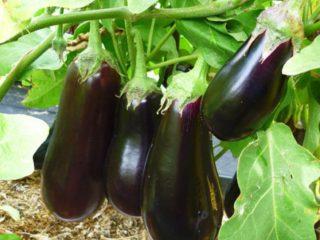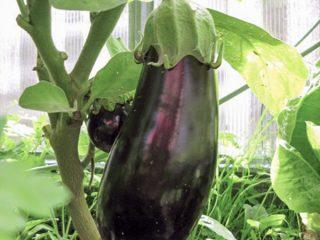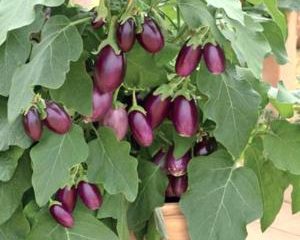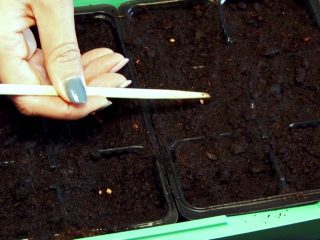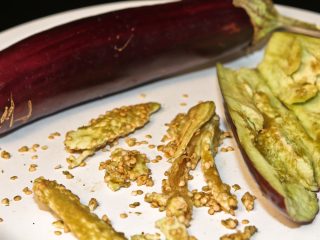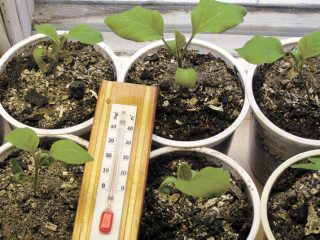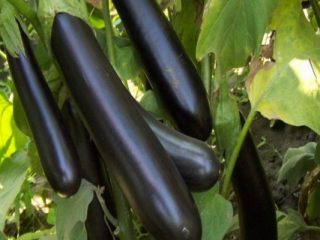Content
Eggplant leaves drying out in a greenhouse is a problem that every gardener who grows this crop may encounter. Trouble occurs for a number of reasons. To find out which one, you should pay close attention to compliance with the rules of agricultural technology and the plant itself.
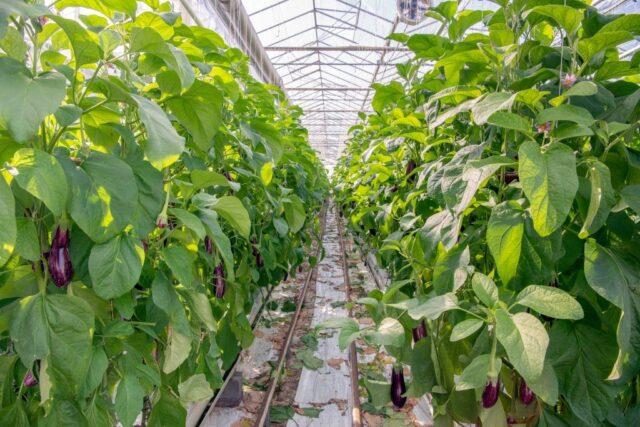
Eggplant is a capricious crop that requires good care, both in the greenhouse and in the open ground.
Why do eggplant leaves dry out?
If eggplant leaves dry out, there may be various reasons for this. Any violation of agricultural technology or inconsistency of conditions in the greenhouse affects the plant. Wilting, yellowing, and drying out of leaf blades is an alarming symptom and requires prompt elimination of the causes of its occurrence.
Unsuitable soil
For good development of eggplants when planting them in a greenhouse, you need to select the right soil. The plant prefers nutritious and loose soil, which it is advisable to prepare in the fall. You cannot plant eggplants in dense or heavy, peaty soil, and it is also not recommended to use sandy or too light soil for this. If there is just such a substrate in the greenhouse, the crop will not develop properly, its leaves will dry out, turn yellow and fall off.
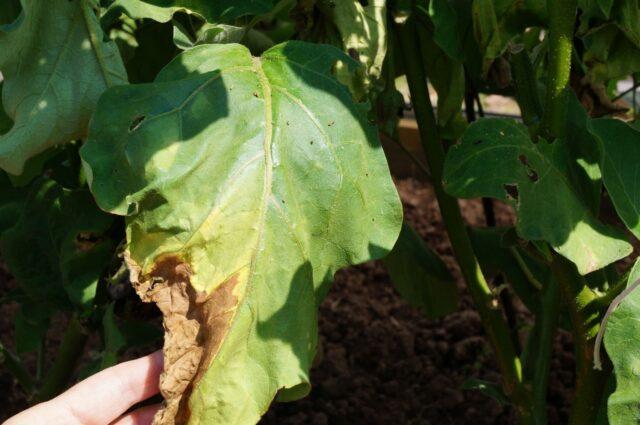
The soil for planting eggplants must have good aeration.
Improper watering
Eggplants love water very much, but overwatering, as well as overdrying, is extremely undesirable for them. In the first case, the roots of the plant begin to rot, and in the second, they begin to dry out, which first of all affects the condition of the above-ground part of the bush.
Watering twice a week is considered optimal for eggplants growing in a greenhouse. When flowers and fruits appear on the plant, the frequency of moistening is increased up to three times. In this case, about 5 liters of water are used per plant.
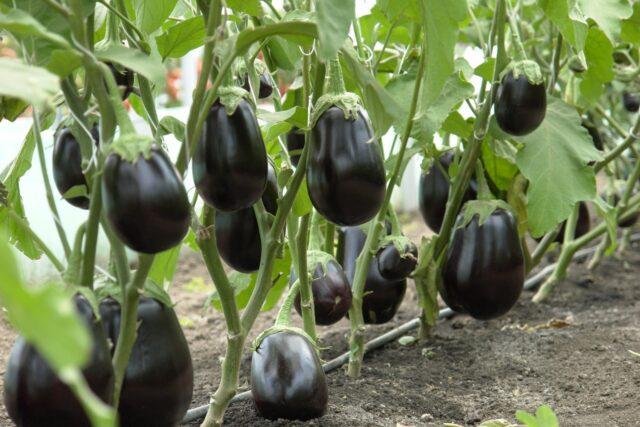
The crop is watered at the root, and it is best to use drip irrigation
Temperature changes
Eggplant is a heat-loving plant that reacts painfully to cold, but at temperatures in the greenhouse of more than +27 ° C it also feels bad. Due to extreme heat, the leaves of the crop dry out, lose their elasticity and fall off. Regulating the temperature helps prevent problems.When the thermometer rises, the doors and windows in the greenhouse are opened, but everything is closed at night, because if the temperature drops to +15 °C, the eggplants will get sick and stop forming fruits. The leaves may also turn yellow and dry out.
Lack of light
In a greenhouse, a plant often suffers from a lack of light, for which gardeners install phytolamps there. As a result, if they are used unwisely, eggplant leaves get burned, the plates begin to dry out and curl.
In order for the bushes to receive enough light, they need to be planted correctly. Eggplants are spreading and powerful, they do not tolerate close proximity to each other, they are placed in a maximum of three pieces per square meter. It is also important when growing in a greenhouse to form them into one or two stems so that excess shoots do not thicken the plantings. Otherwise, the bushes will be deprived of sunlight, and their leaves will also begin to dry out.
Nutrient deficiencies
The appearance of eggplant bushes also changes due to a lack of nutrients. Typically, the leaves turn yellow, curl and dry out due to a lack of potassium. In addition, they can lighten and fade due to nitrogen deficiency. If the leaf blades become yellowish and their veins remain dark green, this indicates a lack of magnesium.
Feeding helps to cope with the problem. They are usually introduced according to the following scheme:
- After picking and a week before transplanting into the greenhouse, the eggplants are watered with a solution of potassium, phosphorus and nitrogen.
- A couple of weeks after planting, fertilize with the same mixture.
- At the time of flowering and fruit set, potassium and phosphorus.
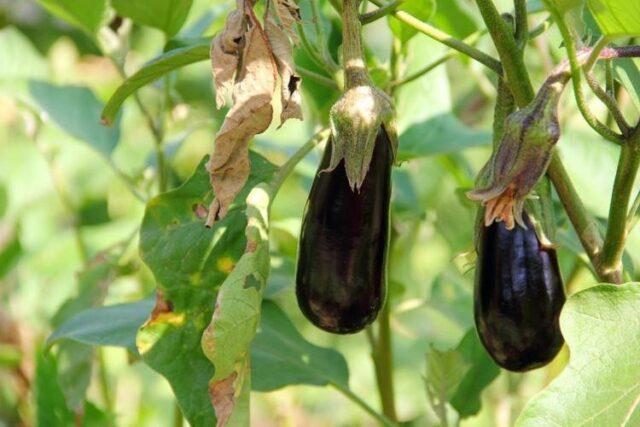
Universal compounds for vegetable crops can be used as fertilizer for eggplants.
Transplant stress
To prevent the plant from getting stressed after transplantation, often when growing in a warm greenhouse, eggplants are immediately sown in a permanent place. And if you have to grow seedlings at home, it is recommended to harden them off correctly. If the bushes do not undergo adaptation, their leaves begin to dry out and fall off. This process is natural, and usually after a few weeks the culture returns to its healthy appearance.
Root damage
Often the delicate root system of eggplants is damaged when they are transplanted into a greenhouse, which can cause the foliage to dry out and change color. To prevent this from happening, it is best to grow seedlings in peat pots or separate cups and move them to the garden bed along with a lump of earth using the transshipment method.
Excess sunlight
In hot weather, eggplant leaves may dry out due to sunlight, although this rarely happens in a greenhouse. This usually happens when plants are watered from above.
Diseases and pests
Eggplant foliage can also dry out due to various diseases or pest attacks. In this case, the problem is immediately reflected in the appearance of the bushes. In addition to drying out the leaf plates, they begin to turn yellow, wither and fall off. The most commonly diagnosed eggplant diseases are:
- Fusarium. The source of the disease is soil, seedlings or seeds. The fungus often manifests itself at the time of flowering of the crop. In this case, first its leaves dry out and turn yellow, and then the entire above-ground part of the plant is affected. Fusarium often appears on acidic soil.
- Gray rot. A fungus that causes leaves to dry out and turn brown. Appears in hot weather with high humidity.
- Mosaic. A virus characterized by yellow patterns on foliage. It is usually spread by insects, or it gets onto the bush through a dirty tool. The disease cannot be cured.
- Late blight. In a greenhouse it is provoked by a violation of crop rotation.
- Chlorosis. Occurs due to nutritional deficiency.
Insects can also cause eggplant leaves to dry out. In a greenhouse, plants are most often attacked by aphids, whiteflies and spider mites.
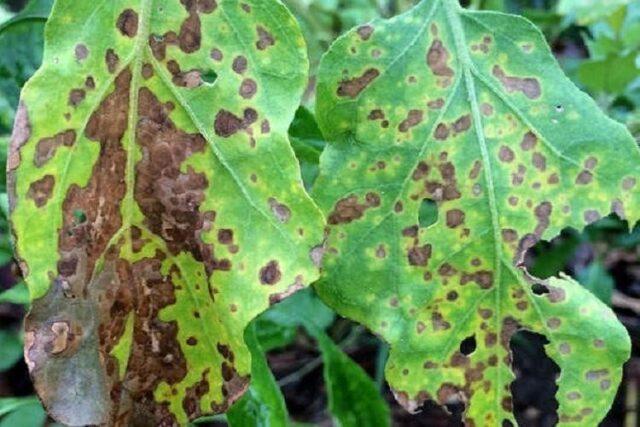
If disease or pest control is not started in time, all plantings may die.
What to do if eggplant leaves dry in a greenhouse
When eggplant leaves turn yellow and dry out, the first step is to understand what caused the problem. This sign is a symptom of a pathological process and goes away only when its cause is eliminated. The sooner this is done, the higher the likelihood of saving the crop.
Proper care
If the leaves begin to dry out due to improper care, then in addition to correcting it, you should help the eggplants cope with stress. It is advisable to fertilize with yeast or boric acid. In the first case, 10 g of the product is diluted in 10 liters of water at room temperature, left for two days, added to water in a ratio of 1:10, and sprayed. In the second case, 5 g of boron is dissolved in 10 ml of hot water, diluted with 10 liters of cold water, and the plantings are irrigated.
Treatment of diseases
In case of eggplant diseases, all leaves with affected areas are cut off and burned from the bushes. Next, the plantings are treated with special preparations: for fusarium - Benazol, Fundazol, Consento, for verticillium wilt - Previkur, Vitaros, Topsin-M.
To prevent the above ailments, as well as tobacco mosaic, eggplants in the greenhouse are sprayed with whey or yeast.
Pest extermination
If the plants are attacked by pests, then in case of small clusters of them, the bushes are treated with an infusion of onion peels, garlic, marigolds or a soap solution. If such actions do not bring results, then biological agents or insecticides are used. Kraft, Kleschevit, Neoron, Aktara, Aktellik help well against spider mites.
To repel insects, preventive procedures are carried out. For this purpose, many vegetable growers grow tansy, calendula, and marigolds in a greenhouse. They prevent caterpillars, Colorado potato beetles, ants and even nematodes from infesting the beds.
Preventive measures
To prevent eggplant leaves from drying out in the greenhouse, it is recommended to take preventive measures. The main one is the organization of proper care: proper watering, maintaining humidity and temperature, timely fertilization, pest and disease control. The crop quickly reacts to errors in agricultural technology, its leaf blades begin to turn yellow, dry out, wither and eventually fall off, the flowers become smaller, and ovaries do not form. You can protect the harvest only by providing all the necessary conditions.
Measures that prevent problems from occurring are:
- Soil renewal.Crop rotation in a greenhouse is difficult to maintain, so every year it is recommended to remove the top layer of soil and replace it with a new one. Be sure to till the soil before planting: loosen heavy soil with manure or sand, add acidic lime, mix peat soil with compost or turf soil.
- Loosening the soil. When the growing season begins, the procedure not only helps air flow to the eggplant roots, but also significantly reduces the risk of developing fungal diseases.
- Hardening of seedlings. To prevent young shoots from starting to dry out after planting, they are gradually accustomed to the conditions in the greenhouse before planting in the ground.
- Organizing proper hydration. At the beginning of the growing season, about three liters of water are consumed per bush once a week, with the onset of flowering 4-5 liters every three days. In this case, the moisturizing solution should be approximately the same temperature as the soil. The procedure is carried out in the evening, strictly under the bush, avoiding water getting on the leaves.
- Ventilation of the greenhouse. With the arrival of hot days, the room becomes stuffy, which is why it is often ventilated. Sometimes containers with cold water are placed between the rows to reduce the temperature.
- Prevention of diseases. In a greenhouse, eggplants are more often exposed to diseases, so before sowing, it is advisable to keep the material in a manganese solution and disinfect the soil. Experienced vegetable growers advise regularly spraying plants with folk remedies, or several times a season with fungicides such as Trichodermin or Anthractol.
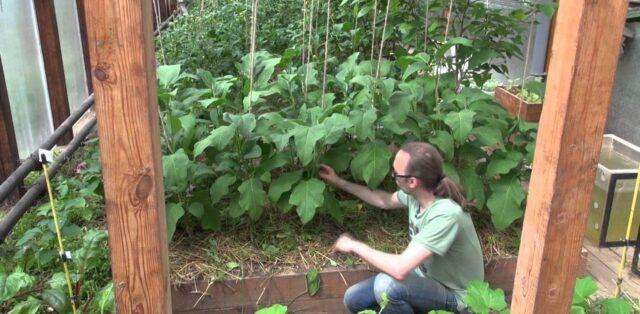
It is better to plant eggplants in a greenhouse away from the entrance to it
Conclusion
Eggplant leaves drying out in a greenhouse is an alarming sign for every gardener.This can be caused by a number of reasons that should be quickly diagnosed and corrected. Leaves can dry out due to disease, unsuitable microclimate in the greenhouse, or pathological processes. In addition, this may be an expression of the natural reaction of eggplants to stress. If the gardener notices the problem in time and eliminates its cause, the crop will quickly regain its strength and be able to produce a good harvest.

